How To Install Iis Server On Windows Server 2012 R2
This browser is no longer supported.
Upgrade to Microsoft Border to take advantage of the latest features, security updates, and technical back up.
Installing IIS eight.5 on Windows Server 2012 R2
This document describes how to install Internet Information Services (IIS) eight.5 on Windows Server® 2012 R2. IIS is the Web server role in Windows Server 2012 R2. The Windows Server 2012 R2 operating system has all the IIS features needed to support the hosting of Web content in product environments. Windows 8 likewise includes IIS features, but feature availability depends on the operating arrangement version.
Note
You can apply the procedures in this certificate to install IIS 8.0 or IIS 8.5.
The Web server has a modular design that enables you to customize a server by adding or removing modules to come across your specific needs. The Install IIS eight.five on Windows Server 2012 R2 section describes how to install modules, and the Modules in IIS 8.5 section below describes the functionality that each module provides and which modules are installed past default.
New in IIS 8.five
IIS 8.5 includes several new features not institute in IIS 8.0 or lower:
- Enhanced logging. An ambassador tin enable the logging of additional custom fields from request or response headers, or from server variables.
- Logging to event tracing for Windows. An administrator tin can enable the sending of logging information to Event Tracing for Windows (ETW).
- Dynamic Website activation. If in that location are a large number of configured sites (100 or greater, by default), the service volition not actuate any of the sites when the service is started.
- Idle Worker Process Page-Out. An administrator can enable an idle worker process to be suspended rather than terminated.
For more information on these features, run across What's New in IIS 8.5.
For information on new features in IIS 8.0, see What's New in IIS 8.0.
Before You Brainstorm
Ensure that you lot have administrative user rights on the reckoner on which yous plan to install IIS 8.5. Note that by default, you do not accept administrative user rights if you are logged on as a user other than as the born administrator, fifty-fifty if you were added to the local Administrators group on the calculator.
Log on either to the congenital-in administrator account, or explicitly invoke applications as the congenital-in ambassador past using the runas command-line tool.
Note
You can run runas /user:administrator cmd.exe and so that every awarding you run from that command line will be elevated, eliminating the demand to use the runas syntax from that control line.
If you are logged on to an account other than the congenital-in local ambassador account, you may see the following security alert dialog box.

Install IIS viii.5 on Windows Server 2012 R2
IIS is one of the server roles on Windows Server 2012 R2, named Spider web Server (IIS). You tin employ the following to install IIS:
- The Server Manager user interface in Windows Server 2012 R2
- A control-line installation using DISM (Deployment Prototype Servicing and Management)
- A command-line installation using PowerShell cmdlets
Note
IIS can also exist installed on Windows eight through the Turn Windows features on or off dialog box from the Programs and Features settings of the Control Panel.
Install IIS 8.5 using the Server Manager
Server Manager provides a single dashboard to install or uninstall server roles, role services, and features. Server Manager also gives an overview of all currently installed roles and features.
When you install IIS viii.v using the Windows Server 2012 R2 Server Director, the steps you perform are different when you install IIS for the first time, every bit opposed to when you lot add roles, services, or features to an existing IIS installation. The 2 procedures are provided beneath. Unlike procedures are also used to add and remove roles, office services, and features. You cannot add and remove from the aforementioned UI
For more data on how to run the installation wizards in Server Manager, see Install or Uninstall Roles, Office Services, or Features.
Install IIS 8.5 for the first time in the Server Manager
When the Spider web Server (UI) role is called for the first time in the Add together Roles and Features Wizard in Server Managing director, the basic components and services needed for IIS are automatically selected. The following procedure will install Internet Data Services on a running physical server when IIS has not already been installed. To change an existing installation of IIS, perform the next procedure, Install additional role services for IIS. These 2 procedures involve different steps.
-
Open Server Manager by clicking the Server Manager icon on the desktop.
-
In the Server Director window, with the Dashboard and Quick First selected, click Add roles and features, or click the Manage carte du jour, and then click Add Roles and Features. The Add Roles and Features Wizard will showtime with a Before You Begin page. The wizard asks for verification of the following:
- The administrator account has a potent countersign.
- The network settings, such equally IP addresses, are configured.
- The most current security updates from Windows® Update are installed.
-
On the Earlier You Brainstorm page, click Next.
-
On the Installation Blazon page, select Role-based or feature-based installation to configure a single server. Click Side by side.

-
On the Server Pick page, select Select a server from the server pool, then select a server; or select Select a virtual hd server, select a server to mount the VHD on, and and then select a VHD file. Click Next.
Notation
To connect to the virtual hard deejay, the virtual auto must be turned off and disconnected. If you select a VHD file from a network share, that share must grant Read and Write permissions to the computer (local system) business relationship of the server that yous selected to mount the VHD (user-only account access is not sufficient).
Note
Servers in a server pool will exist available merely if they have been added by the Add together other servers to manage command in Server Manager.

-
On the Server Roles page, select Web Server (IIS).

-
In the Add together Roles and Features wizard, click Add Features if yous want to install the IIS Management Console. If y'all do non want to install the Management Console, uncheck Include management tools (if applicative), and then click Continue.

-
On the Server Roles folio, click Side by side.
Note
The features required for the default role services of Management Tools and IIS Management Console will be preselected in the Features page.
-
On the Features page, select any features that you lot would like to install, and then click Next. Notation that you do not need to select any features on this page to install IIS. IIS setup will select the features that are required.

-
On the Web Server Role (IIS) page, click Next.
-
On the Role Services page, select whatever boosted role services that y'all desire to install.
Note
When you install IIS for the start time by selecting Spider web Server (IIS), y'all will get at least the default installation that includes a minimum set of role services. You can see at this point that those default services are preselected on the Server Roles page. For a list of the server roles available, and which roles are installed by default, see Modules in IIS 8.5. You will have the chance to select more role services later in this process.
Notation
You tin also deselect role services that were selected by default when you selected Web Server. Nonetheless, at least one part service must be selected for Spider web Server to be selected and installed.

-
If you selected a part service that requires other role services or features to be installed, a page will be opened indicating the role services or features to be installed. Leave Include management tools (if applicative) selected to select the install management tools associated with the server function. You lot may not need the management tools on the destination server if y'all programme to manage the role remotely. Click Add together Features to add the required role services or features.
-
After y'all have added the part services that y'all need on the Role Services page, click Next.
-
On the Confirmation folio, verify the role services and features that are selected. Select Restart the destination server automatically if required to restart the destination server if the settings demand to take immediate effect. To salve the configuration information to an XML-based file that you can utilise for unattended installations with Windows PowerShell, select Export configuration settings, movement to the appropriate path in the Save As dialog box, enter a file name, and and then click Save.
When you are set up to starting time the installation process on the Confirmation page, click Install.

-
The Installation Progress page is displayed. You can close the magician without interrupting running tasks. You can view task progress or open up the folio again past clicking Notifications in the notification expanse, so clicking Job Details.

-
On the Results folio, verify that the installation succeeds, and then click Close.

-
Confirm that the Web server works past opening a Web browser, and verifying that the following default Spider web folio is displayed when you use the
http://localhostaccost.
Install additional IIS eight.5 office services in the Server Managing director
After you accept installed the Web Server part on a running physical server for the outset time, y'all tin can run through the installation procedure again to install additional roles, role services, and features.
-
Open Server Manager by clicking the Server Manager icon on the desktop.
-
In the Server Manager window, with the Dashboard and Quick Offset selected, click Add roles and features, or click the Manage menu, and so click Add Roles and Features. The Add Roles and Features wizard will start with a Before You Begin page. The sorcerer asks for verification of the post-obit:
- The administrator account has a strong countersign.
- The network settings, such as IP addresses, are configured.
- The well-nigh current security updates from Windows® Update are installed.
-
On the Before You Begin folio, click Adjacent.
-
On the Installation Type page, select Role-based or feature-based installation to configure a single server. Click Adjacent.

-
On the Server Selection page, select Select a server from the server pool, and so select a server; or select Select a virtual hard disk server, select the server to mount the VHD on, and and then select the VHD file. Click Adjacent.
Notation
To connect to the virtual hard disk drive, the virtual machine must be turned off and disconnected. If you select a VHD file from a network share, that share must grant Read and Write permissions to the computer (local system) account of the server that y'all selected to mount the VHD (user-just business relationship admission is not sufficient).
Note
Servers in a server puddle will be available only if they have been added by the Add together other servers to manage command in the Server Director.
Annotation
On the Server Roles folio, Web Server (IIS) will be selected when IIS 8.0 has already been installed. If Web server (IIS) is not selected, perform the procedure in Install IIS eight.5 for the first time in the Server Manager.

-
On the Server Roles page, open up the Web Server (IIS) tree until you see a role service that you desire to install. Select the role service.
Note
Those roles, services, and features that accept already been installed will exist identified by "Installed" in parentheses afterwards the proper noun, and the proper noun will exist grayed out. To remove a part, service, or feature, see Uninstall IIS eight.5 Using the Server Managing director. Note, still, that you tin expand the lower-level entries nether a node even when the node is grayed out.
Note
For a list of the server roles that are available, and which roles are installed by default, see Modules in IIS 8.5 below.
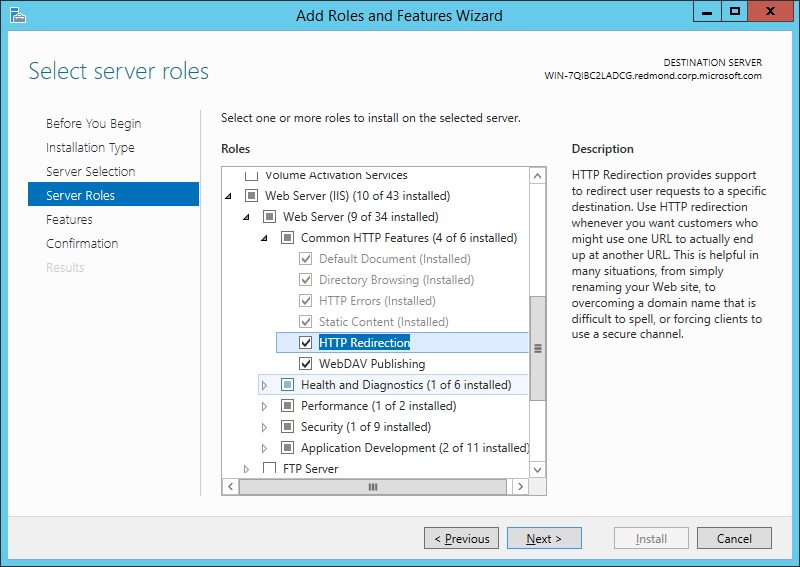
-
If the role service that you selected requires other role services or features to be installed, an Add Features page will be opened listing those required role services or features. Leave Include management tools (if applicable) selected to select the install management tools associated with the server role. You lot may not need the direction tools on the destination server if y'all plan to manage the role remotely. Click Add Features to add the required role services or features to the installation.

-
If you demand any additional role services, repeat steps vi and 7.
Note
Add only the modules that are necessary to minimize the IIS installation footprint and the attack surface.
When you have selected all required role services, and their dependencies, on the Server Roles folio, click Next.
-
On the Features page, select any features that you demand to exist installed. Whatever features required to be installed for role services that y'all selected in step 6 will already be selected. Click Adjacent.
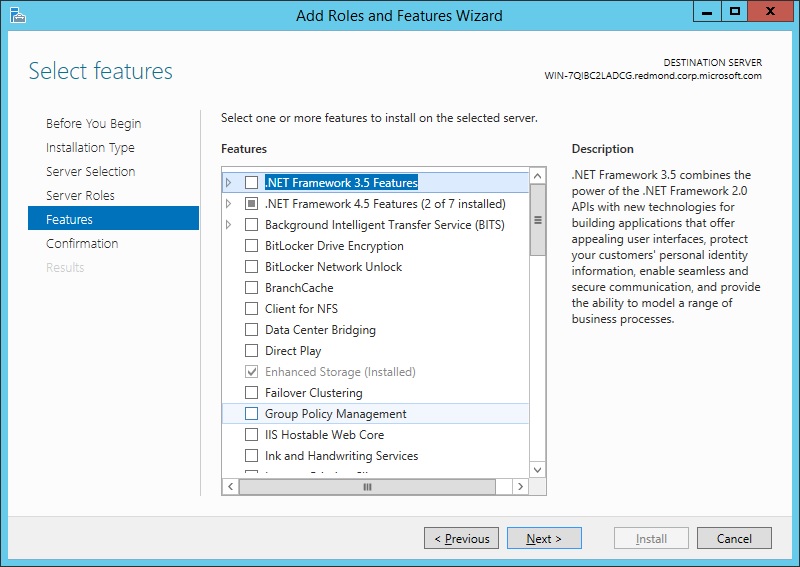
-
On the Confirmation folio, verify the role services and features that are selected. Select Restart the destination server automatically if required to restart the destination server if the settings demand to take immediate effect. To salvage the configuration information to an XML-based file that y'all tin can use for unattended installations with Windows PowerShell, select Consign configuration settings, motion to the appropriate path in the Save As dialog box, enter a file proper name, and and then click Save.
When you are set to start the installation process on the Confirmation page, click Install.
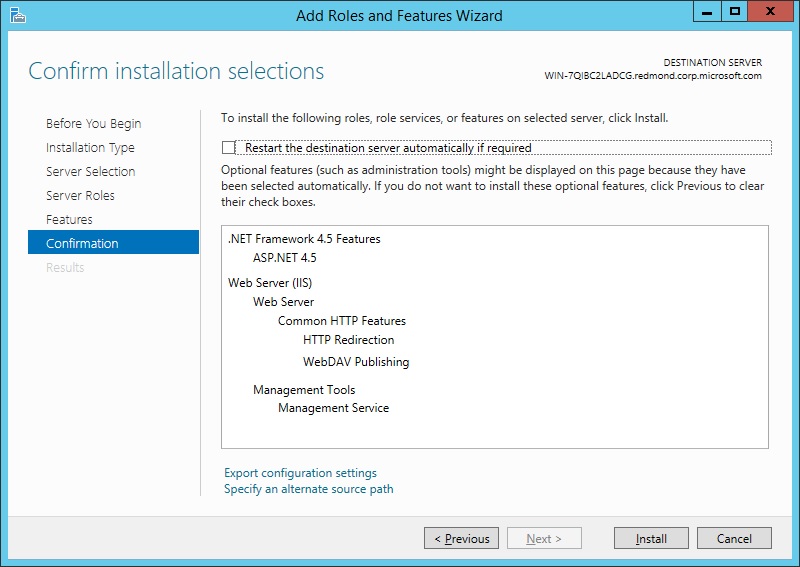
-
The Installation Progress folio is displayed. Y'all tin can close the wizard without interrupting running tasks. Yous can view task progress or open up the page again by clicking Notifications in the notification surface area, and then clicking Task Details.

-
On the Results page, verify that the installation succeeds, and then click Close.
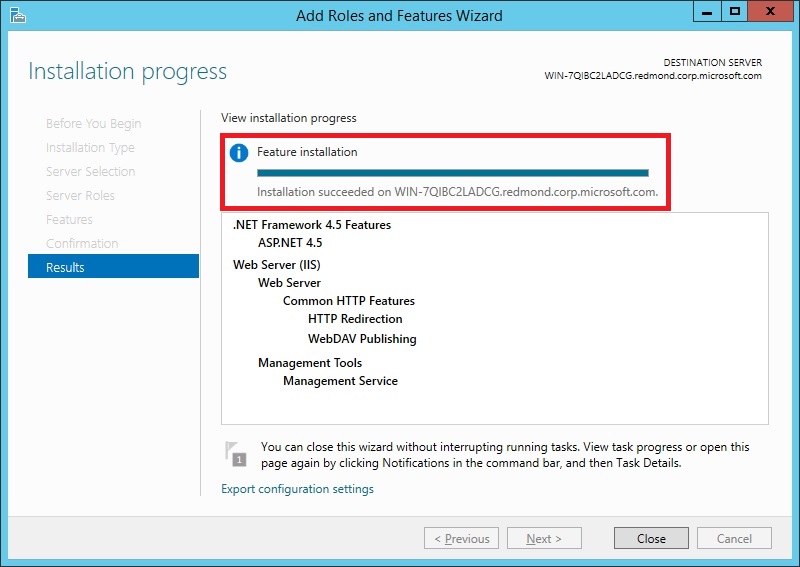
-
Ostend that the Web server works by opening a Spider web browser, and verifying that the following default Web page when y'all use the
http://localhostaddress.
Uninstall IIS 8.5 using the Server Manager
In the Add Roles and Features magician of Server Managing director, you cannot delete existing features that have already been installed. To delete roles and features, use the Remove Roles and Features sorcerer of Server Director. Y'all can remove an individual role, role service, or feature by unchecking information technology in the sorcerer, or you lot can uninstall all of IIS by unchecking the IIS Web Server Function.
-
Open Server Manager by clicking the Server Manager icon on the desktop.
-
Click Manage at the top of the Server Manager, and and then click Remove Roles and Features.
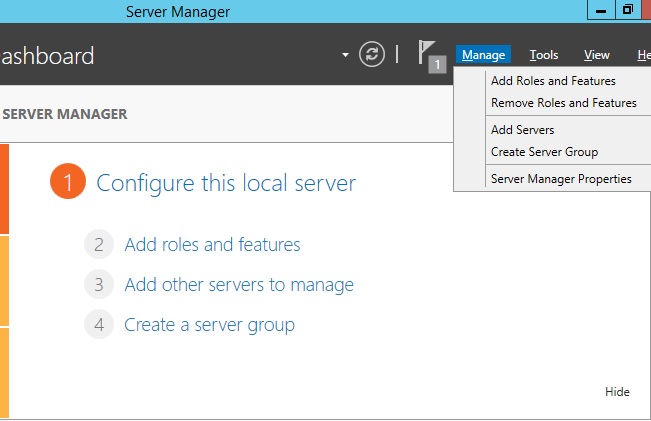
-
On the Before y'all brainstorm page, click Adjacent.
-
On the Server Option page, select the server from the server pool, and so click Next.

-
On the Remove Server Roles page, clear the check box of any server role or role service that you would like to remove.
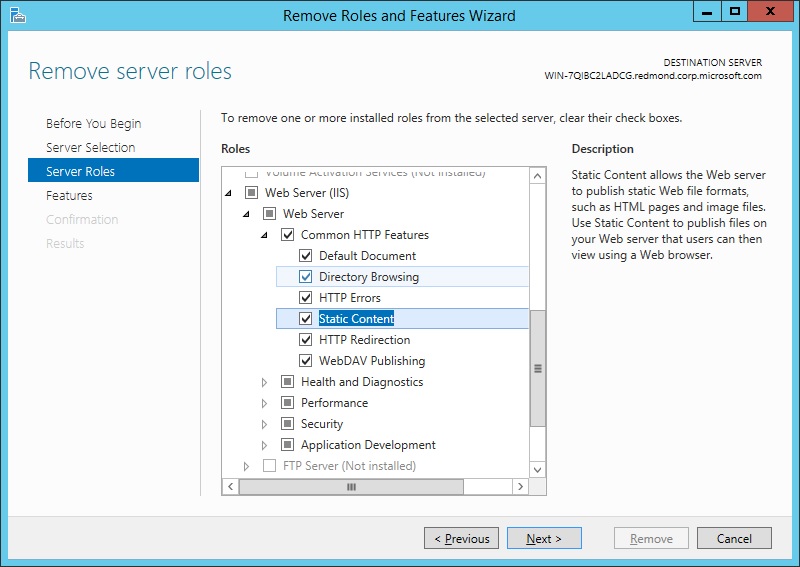
-
If yous uncheck a part service that has feature dependencies, the Remove Features dialog box will be displayed showing the dependencies. Click Remove Features to remove them. You tin can remove all of IIS by unchecking Web Server (IIS).
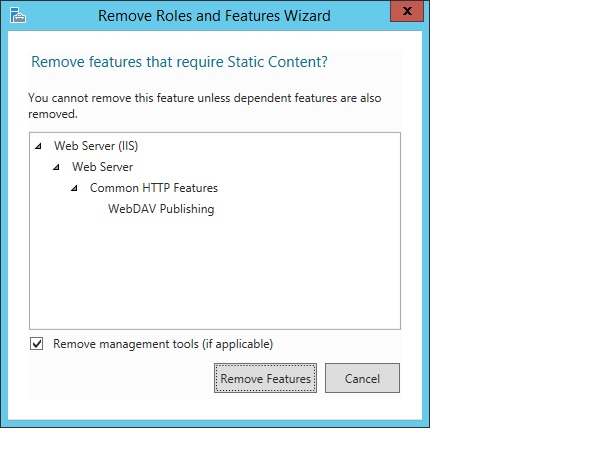
-
On the Remove Server Roles page, select whatever other office or role service that you want to remove, and so click Adjacent.
-
On the Features page, uncheck any feature that y'all would like to remove. If you lot uncheck a feature that has feature dependencies, a dialog box will exist displayed showing the dependencies. Click Remove Features to remove them. On the Features page, click Next.
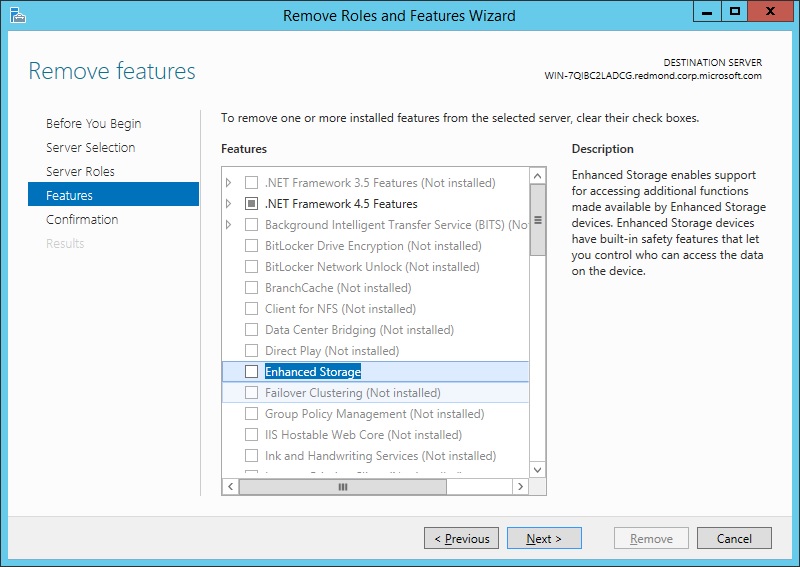
-
On the Confirmation folio, verify that the roles, part services, and features to be removed are correct, and then click Remove.
Note
It is recommended that you do a restart if you lot are prompted to practise so, unless you have other activities that y'all want to practice earlier the restart takes identify. A restart is specially important when you remove roles, role services, or features.
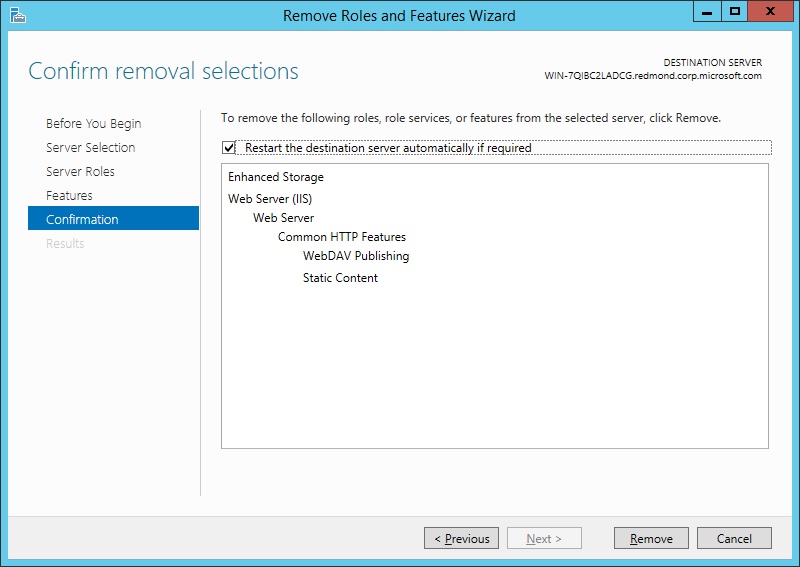
-
The Removal Progress page is displayed. You lot can close the wizard without interrupting running tasks. You lot tin view job progress or open the page once again by clicking Notifications in the notification area, and so clicking Task Details.
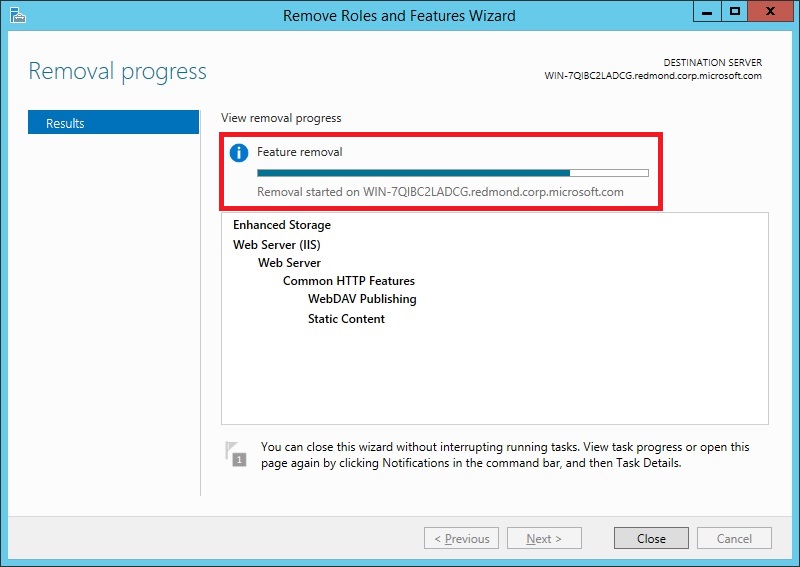
-
On the Results folio, click Close.
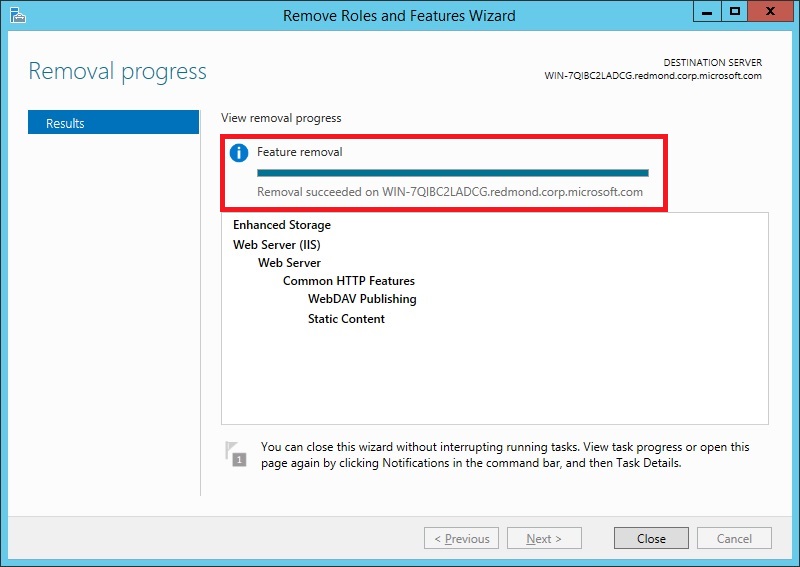
-
Restart the destination server to finish removing features.
Install IIS 8.v from the Control Line
You tin can install IIS 8.v from the control line using DISM or PowerShell. Note that DISM and PowerShell have unlike namespaces for installation parameters, so the parameter names used in their commands will be different. For more than information, see Modules in IIS eight.v.
Note
Pkgmgr.exe has been deprecated. Employ DISM instead for scripts installing IIS viii.five.
Install IIS 8.v using DISM
Automating the installation of IIS past using unattended scripts is very useful if y'all need to deploy multiple Spider web servers and want to ensure that each of the Web servers is gear up with identical components and services. In Windows Server 2012 R2, DISM is used for unattended scripts, letting yous install or uninstall optional features from a command prompt or scripts. To use DISM, yous must brand sure yous accept administrative user rights on the estimator. For more than information about DISM, see DISM Overview
If you exercise not explicitly include in the DISM code a feature that the IIS installation has a dependency on, the installation will neglect, and will not generate an error message. For a listing of dependencies required, run across Characteristic Dependencies.
For a full list of the DISM parameters corresponding to IIS roles, services, and features, come across Modules in IIS 8.5.
The following script will install all roles, role services, and features of IIS 8.5, getting the total IIS installation that includes all bachelor feature packages. If at that place are roles, office services, or features that yous practise non need, you should edit the script to include merely those that yous require. The order of the commands in the DISM script does not affair. The unabridged script will be handed off to the engine and treated as ane transaction. To install IIS 8.5 with a script, type the following on 1 line in an elevated control prompt.
DISM.EXE /enable-feature /online /featureName:IIS-WebServerRole /featureName:IIS-WebServer /featureName:IIS-CommonHttpFeatures /featureName:IIS-StaticContent /featureName:IIS-DefaultDocument /featureName:IIS-DirectoryBrowsing /featureName:IIS-HttpErrors /featureName:IIS-HttpRedirect /featureName:IIS-ApplicationDevelopment /featureName:IIS-ASPNET /featureName:IIS-NetFxExtensibility /featureName:IIS-ASPNET45 /featureName:IIS-NetFxExtensibility45 /featureName:IIS-ASP /featureName:IIS-CGI /featureName:IIS-ISAPIExtensions /featureName:IIS-ISAPIFilter /featureName:IIS-ServerSideIncludes /featureName:IIS-HealthAndDiagnostics /featureName:IIS-HttpLogging /featureName:IIS-LoggingLibraries /featureName:IIS-RequestMonitor /featureName:IIS-HttpTracing /featureName:IIS-CustomLogging /featureName:IIS-ODBCLogging /featureName:IIS-Security /featureName:IIS-BasicAuthentication /featureName:IIS-WindowsAuthentication /featureName:IIS-DigestAuthentication /featureName:IIS-ClientCertificateMappingAuthentication /featureName:IIS-IISCertificateMappingAuthentication /featureName:IIS-URLAuthorization /featureName:IIS-RequestFiltering /featureName:IIS-IPSecurity /featureName:IIS-Functioning /featureName:IIS-HttpCompressionStatic /featureName:IIS-HttpCompressionDynamic /featureName:IIS-WebDAV /featureName:IIS-WebServerManagementTools /featureName:IIS-ManagementScriptingTools /featureName:IIS-ManagementService /featureName:IIS-IIS6ManagementCompatibility /featureName:IIS-Metabase /featureName:IIS-WMICompatibility /featureName:IIS-LegacyScripts /featureName:IIS-FTPServer /featureName:IIS-FTPSvc /featureName:IIS-FTPExtensibility /featureName:NetFx4Extended-ASPNET45 /featureName:IIS-ApplicationInit /featureName:IIS-WebSockets /featureName:IIS-CertProvider /featureName:IIS-ManagementConsole /featureName:IIS-LegacySnapIn Install IIS 8.v using PowerShell
You can use the following PowerShell cmdlets to install all of IIS 8.v:
import-module servermanager add-windowsfeature web-server -includeallsubfeature To install merely specific features, listing them in the PowerShell cmdlet, every bit in the following example:
import-module servermanager add-windowsfeature Spider web-Server, Web-WebServer, Web-Security, Spider web-Filtering The post-obit points apply to running the PowerShell cmdlets:
- The cmdlet requires elevation. You must be running a Windows PowerShell session every bit an ambassador to run the cmdlet.
- The cmdlet does not install direction tools for roles, part services, and features by default. You must add the IncludeManagementTools parameter to the cmdlet to practice so.
For a full listing of the PowerShell parameters respective to IIS eight.5 roles, services, and features, with more data, see Modules in IIS eight.v. The following lists all these parameters.
- Spider web-Server
- Web-WebServer
- Spider web-Security
- Web-Filtering
- Spider web-Cert-Auth
- Web-IP-Security
- Web-Url-Auth
- Web-Windows-Auth
- Web-Basic-Auth
- Web-Customer-Auth
- Web-Digest-Auth
- Web-CertProvider
- Web-Common-Http
- Spider web-Http-Errors
- Spider web-Dir-Browsing
- Web-Static-Content
- Web-Default-Doc
- Spider web-Http-Redirect
- Web-DAV-Publishing
- Web-Performance
- Spider web-Stat-Compression
- Spider web-Dyn-Compression
- Web-Health
- Web-Http-Logging
- Web-ODBC-Logging
- Web-Log-Libraries
- Spider web-Custom-Logging
- Web-Request-Monitor
- Spider web-Http-Tracing
- Web-App-Dev
- Web-Internet-Ext
- Spider web-Net-Ext45
- Web-ASP
- Web-Asp-Net
- Web-Asp-Net45
- Web-CGI
- Web-ISAPI-Ext
- Web-ISAPI-Filter
- Web-WebSockets
- Web-AppInit
- Web-Includes
- Web-Ftp-Server
- Web-Ftp-Service
- Spider web-Ftp-Ext
- Web-Mgmt-Tools
- Web-Mgmt-Console
- Web-Mgmt-Compat
- Web-Metabase
- Web-WMI
- Web-Lgcy-Mgmt-Console
- Spider web-Lgcy-Scripting
- Spider web-Scripting-Tools
- Web-Mgmt-Service
Uninstall IIS 8.five using PowerShell
You lot can use the PowerShell cmdlet UnInstall-WindowsFeature to uninstall IIS 8.5. Run get-help Install-WindowsFeature at a PowerShell command line to encounter the syntax of the cmdlet. The following points apply to running the cmdlet:
- The cmdlet requires elevation. You lot must be running a Windows PowerShell session as an administrator to run the cmdlet.
- The cmdlet does non uninstall management tools for roles, role services, and features by default. Yous must add the IncludeManagementTools parameter to the cmdlet to practice then.
Modules in IIS 8.5
IIS modules are individual function services that the server uses to process requests. The following tabular array shows which modules are available to exist installed in the Spider web server, which are installed past default, which role the function service is included in, the parameter used in DISM or PowerShell to install them, and a brief description of the functionality that they provide.
Annotation
An asterisk (*) in the table beneath denotes a role or function service that is installed by default when the Web Server (IIS) role is installed.
| Role | Role Service | DISM Parameter | PowerShell Parameter | Functionality |
|---|---|---|---|---|
| Spider web Server Part | IIS-WebServerRole | Web-Server | Provides back up for HTML Web sites and optional support for ASP.Internet, ASP, and Web server extensions, enabling y'all to host an internal or external Web site or create Web-based applications. | |
| Web Server* | IIS-WebServer | Web-WebServer | Provides support for HTML Web sites and optional support for ASP.Internet, ASP, and Web server extensions, enabling you to host an internal or external Web site or create Web-based applications. | |
| Common HTTP Features* | IIS-CommonHttpFeatures | Web-Common-Http | Supports basic HTTP functionality, such as delivering standard file formats and configuring custom server properties. | |
| Default Document* | IIS-DefaultDocument | Web-Default-Doc | Enables y'all to configure a default file for the Web server to return when users do not specify a file in a request URL. | |
| Directory Browsing* | IIS-DirectoryBrowsing | Spider web-Dir-Browsing | Enables users to encounter the contents of a directory on a Web server when they exercise non specify a file in a asking URL and default documents are either disabled or not configured. | |
| HTTP Errors* | IIS-HttpErrors | Web-Http-Errors | Enables you to customize the error messages that are returned to the users' browsers when the Web server detects a error condition, improving the user feel. | |
| Static Content* | IIS-StaticContent | Web-Static-Content | Enables the Spider web server to publish static Web file formats, such equally HTML pages and epitome files that can exist viewed using a Web browser. | |
| HTTP Redirection | IIS-HttpRedirect | Web-Http-Redirect | Enables the Web server to redirect user requests that are sent to a specific destination. | |
| WebDAV Publishing | IIS-WebDAV | Web-DAV-Publishing | Web Distributed Authoring and Versioning. Enables you to publish files to and from a Web server by using the HTTP protocol, working through most firewalls without modification. | |
| Health and Diagnostics* | IIS-HealthAndDiagnostics | Spider web-Health | Provides an infrastructure to monitor, manage, and troubleshoot the health of Web servers, sites, and applications. | |
| HTTP Logging* | IIS-HttpLogging | Web-Http-Logging | Provides logging of Web site activity for the server, in addition to the logging provided past the operating arrangement. | |
| Custom Logging | IIS-CustomLogging | Web-Custom-Logging | Enables you to create a custom logging module that performs logging of Web server activeness in a format that differs from the logging normally performed by IIS. | |
| Logging Tools | IIS-LoggingLibraries | Web-Log-Libraries | Provides an infrastructure to manage Web server logs and automate common logging tasks. | |
| ODBC Logging | IIS-ODBCLogging | Web-ODBC-Logging | Provides an infrastructure that supports logging Web server activity to an ODBC-compliant database, enabling you to programmatically display and manipulate logging data on an HTML folio. | |
| Asking Monitor | IIS-RequestMonitor | Web-Request-Monitor | Provides an infrastructure to monitor Web application health by capturing information about HTTP requests. | |
| Tracing | IIS-HttpTracing | Web-Http-Tracing | Provides an infrastructure to diagnose and troubleshoot Spider web applications, including poor performance and authentication-related failures. | |
| Performance* | IIS-Operation | Spider web-Performance | Provides an infrastructure to enable more than efficient employ of bandwidth past performing compression of static and/or dynamic content. | |
| Static Content Compression* | IIS-HttpCompressionStatic | Web-Stat-Compression | Provides an infrastructure to configure HTTP compression of static content. | |
| Dynamic Content Compression | IIS-HttpCompressionDynamic | Web-Dyn-Compression | Provides an infrastructure to configure HTTP pinch of dynamic content. | |
| Security* | IIS-Security | Web-Security | Provides an infrastructure for securing the Spider web server from users and requests, using ane of multiple authentication methods. | |
| Request filtering* | IIS-RequestFiltering | Web-Filtering | Enables screening of all incoming requests to the server, and filters the requests based upon rules set by the administrator. | |
| Bones Authentication | IIS-BasicAuthentication | Web-Basic-Auth | An authentication method in which users are prompted to supply credentials that are transmitted unencrypted beyond the network. | |
| Centralized SSL Certificate | IIS-CertProvider | Web-CertProvider | An authentication method that uses SSL server certificates that are managed centrally using a file share. | |
| Client Certificate Mapping Authentication | IIS-ClientCertificateMappingAuthentication | Web-Customer-Auth | An authentication method that uses customer certificates to authenticate users, using Active Directory to offer one-to-ane certificate mappings across multiple Spider web servers. | |
| Assimilate Authentication | IIS-DigestAuthentication | Web-Digest-Auth | An authentication method that sends a password hash to a Windows domain controller to authenticate users, specially useful if users who must exist authenticated will access the Web site from behind firewalls and proxy servers. | |
| IIS Client Certificate Mapping Authentication | IIS-IISCertificateMappingAuthentication | Web-Cert-Auth | An authentication method that uses customer certificates to authenticate users, using IIS to offer one-to-one or many-to-ane certificate mapping. | |
| IP and Domain Restrictions | IIS-IPSecurity | Web-IP-Security | An authentication method that enables you to enable or deny content based upon the originating IP accost or the domain proper name of the request. | |
| URL Authorization | IIS-URLAuthorization | Web-Url-Auth | An authentication method that enables you to create URL authority rules that restrict access to Web content. | |
| Windows Authentication | IIS-WindowsAuthentication | Web-Windows-Auth | An hallmark method that enables administrators in a Windows domain to take advantage of the domain infrastructure for authenticating users, a depression-cost hallmark solution for internal Web sites. | |
| Application Development | IIS-ApplicationDevelopment | Web-App-Dev | Provides an infrastructure for developing and hosting Web applications, useful for creating Web content and extending the functionality of IIS. | |
| .Cyberspace Extensibility iii.v | IIS-NetFxExtensibility | Spider web-Cyberspace-Ext | Enables managed lawmaking developers to change, add, and extend Web server functionality in the unabridged request pipeline, the configuration, and the UI. | |
| .NET Extensibility 4.5 | IIS-NetFxExtensibility45 | Web-Net-Ext45 | Enables managed lawmaking developers to change, add together, and extend Web server functionality in the entire request pipeline, the configuration, and the UI. | |
| Awarding Initialization | IIS-ApplicationInit | Web-AppInit | Enables you to perform expensive Web awarding initialization tasks earlier serving Spider web pages. | |
| ASP | IIS-ASP | Web-ASP | Provides a server-side scripting environs for building Web sites and Spider web applications, peculiarly for existing applications. | |
| ASP.NET 3.5 | IIS-ASPNET | Spider web-Asp-Cyberspace | Provides a server-side object-oriented programming environment for building Web sites and Web applications using managed code. | |
| ASP.NET 4.5 | IIS-ASPNET45 | Spider web-Asp-Net45 | Provides a server-side object-oriented programming surroundings for building Web sites and Web applications using managed lawmaking. | |
| CGI | IIS-CGI | Web-CGI | Defines how a Spider web server passes information to an external program. | |
| ISAPI Extensions | IIS-ISAPIExtensions | Web-ISAPI-Ext | Cyberspace Server Programming Interface Extensions. Provides support for dynamic Web content development. | |
| ISAPI Filters | IIS-ISAPIFilter | Web-ISAPI-Filter | Internet Server Programming Interface Filters. Enables you to extend or change the functionality provided by IIS, reviewing every asking made to the Web server and processing the appropriate requests. | |
| Server Side Includes | IIS-ServerSideIncludes | Web-Includes | A scripting language used to dynamically generate HTML pages, using script that is run on the server earlier the folio is delivered to the client. | |
| WebSocket Protocol | IIS-WebSockets | Web-WebSockets | Provides communication channels for server applications created with IIS viii.x and ASP.Internet iv.5. | |
| FTP Server | IIS-FTPServer | Web-Ftp-Server | Enables the transfer of files between a client and a server, using either an FTP client or an FTP-enabled Web browser. | |
| FTP Service | IIS-FTPSvc | Web-Ftp-Service | Enables FTP publishing on a Spider web server. | |
| FTP Extensibility | IIS-FTPExtensibility | Web-Ftp-Ext | Enables support for FTP extensibility features such equally customer providers, ASP.NET users, or IIS Manager users. | |
| IIS Hostable Web Cadre (IIS 8.0, not IIS 8.five) | IIS-HostableWebCore | Web-WHC | Enables you lot to write custom code that will host core IIS functionality in your ain application that serves HTTP requests and uses its own applicationHost.config and root Web.config configuration files. | |
| Management Tools* | IIS-WebServerManagementTools | Web-Mgmt-Tools | Provides an infrastructure for managing a Web server that runs IIS 7.0 or afterward. | |
| IIS Direction Panel* | IIS-ManagementConsole | Spider web-Mgmt-Panel | Provides an infrastructure for managing an IIS seven.0 or after Web server, local or remote, using a user interface. | |
| IIS 6 Management Compatibility | IIS-IIS6ManagementCompatibility | Spider web-Mgmt-Compat | Provides forward compatibility for applications and scripts that use the IIS 6 APIs, Admin Base Object (ABO) and Agile Directory Service Interface (ADSI). | |
| IIS vi Metabase Compatibility | IIS-Metabase | Web-Metabase | Provides an infrastructure for querying and configuring the Metabase, and so that yous can run applications and scripts migrated from earlier versions of IIS that use Admin Base Object (ABO), and Active Directory Service Interface (ADSI). | |
| IIS 6 Direction Panel | IIS-LegacySnapIn | Web-Lgcy-Mgmt-Console | Provides an infrastructure for administration of remote IIS six.0 servers. | |
| IIS 6 Scripting Tools | IIS-LegacyScripts | Web-Lgcy-Scripting | Enable you to keep to use scripts congenital to manage IIS half dozen in IIS vii.0 or later, particularly if your applications and scripts use ActiveX Data Objects (ADO) or Agile Directory Service Interface (ADSI). | |
| IIS 6 WMI Compatibility | IIS-WMICompatibility | Spider web-WMI | Provides Windows Management Instrumentation (WMI) scripting interfaces to programmatically manage and automate tasks for an IIS 8.0 or after Web server. | |
| IIS Management Scripts and Tools | IIS-ManagementScriptingTools | Web-Scripting-Tools | Provides an infrastructure to programmatically manage an IIS 7.0 or later Spider web server by using commands in a command window or by running scripts. | |
| Direction Service | IIS-ManagementService | Web-Mgmt-Service | Enables the Web server to be managed remotely from another computer using IIS Manager. |
Feature Dependencies
The following table shows which role services and features must exist installed for the function service or features in the table row to be installed.
The Add Roles and Features Magician and Remove Roles and Features Wizard of Server Manager take care of dependencies past prompting you to add dependencies when calculation a role service or feature, or to remove dependencies when removing a role service or feature. However, when y'all install IIS using DISM, you demand to include in the DISM code any dependency that a role service or feature beingness installed has, or the installation will fail, and y'all may not receive an indication why it failed.
When you remove a role service or feature, make sure that you do not remove a service or feature that another service or feature has a dependency on. At that place tin can be an intersection of dependencies, for example between ASP and ASP.Net. So if you were to remove ASP, and remove its feature dependencies, yous could remove dependencies for ASP.Internet, every bit well.
| Role | Role Service | Dependency |
|---|---|---|
| Web Server Role | None | |
| Spider web Server* | None | |
| Common HTTP Features* | None | |
| Default Document* | None | |
| Directory Browsing* | None | |
| HTTP Errors* | None | |
| Static Content* | None | |
| HTTP Redirection | None | |
| WebDAV Publishing | Static Content | |
| Health and Diagnostics* | None | |
| HTTP Logging* | None | |
| Custom Logging | None | |
| Logging Tools | None | |
| ODBC Logging | None | |
| Request Monitor | None | |
| Tracing | None | |
| Operation* | None | |
| Static Content Compression* | None | |
| Dynamic Content Compression | None | |
| Security* | None | |
| Request filtering* | None | |
| Basic Authentication | None | |
| Centralized SSL Certificate | None | |
| Client Certificate Mapping Hallmark | None | |
| Digest Authentication | None | |
| IIS Customer Certificate Mapping Authentication | None | |
| IP and Domain Restrictions | None | |
| URL Authorization | None | |
| Windows Authentication | None | |
| Application Evolution | None | |
| .Cyberspace Extensibility 3.5 | - .Internet Framework 3.5 (includes .NET 2.0 and 3.0) - ASP.Cyberspace four.5 - .Cyberspace Framework 4.5 - Application Development - Request Filtering | |
| .NET Extensibility 4.5 | - ASP.Net iv.5 - .Cyberspace Framework 4.5 - Application Development - Request Filtering | |
| Application Initialization | None | |
| ASP | - Web Server (IIS)-Web Server- Application Evolution- ISAPI Extensions - Asking Filtering | |
| ASP.Cyberspace 3.5 | - .NET Framework 3.5 (includes .NET ii.0 and 3.0) - ASP.Cyberspace 4.5 - .NET Framework 4.5 - ISAPI Extensions - ISAPI Filters - .NET Extensibility 3.5 - Request Filtering | |
| ASP.Internet 4.5 | - ASP.Internet 4.v - .NET Framework 4.5 - ISAPI Extensions - ISAPI Filters - .NET Extensibility iii.5 - Request Filtering | |
| CGI | None | |
| ISAPI Extensions | None | |
| ISAPI Filters | None | |
| Server Side Includes | None | |
| WebSocket Protocol | None | |
| FTP Server | None | |
| FTP Service | None | |
| FTP Extensibility | FP Service | |
| IIS Hostable Spider web Cadre (IIS 8.0, not IIS eight.five) | None | |
| Management Tools* | - .Cyberspace Framework iv.5 - Graphic Management Tools and Infrastructure - Windows PowerShell 3.0 | |
| IIS Management Console* | - .NET Framework 4.5 - Graphic Management Tools and Infrastructure - Management Tools - Windows PowerShell 3.0 | |
| IIS 6 Management Compatibility | None | |
| IIS half-dozen Metabase Compatibility | None | |
| IIS 6 Management Console | - .Cyberspace Framework 4.five - Graphic Management Tools and Infrastructure - IIS half-dozen Metabase Compability - Windows PowerShell iii.0 | |
| IIS half dozen Scripting Tools | - IIS 6 Metabase Compatibility - IIS vi WM Compatibility | |
| IIS 6 WMI Compatibility | IIS half dozen Metabase Compatibility | |
| IIS Management Scripts and Tools | None | |
| Management Service | - ASP.Net 4.5 - .Net Framework 4.5 - Management Tools |
See also
- Install or Uninstall Roles, Role Services, or Features
- IIS.Net Install
- What's New in IIS 8.5
- DISM Overview
- Editing Configuration Files
- Extending IIS Configuration
Source: https://docs.microsoft.com/en-us/iis/install/installing-iis-85/installing-iis-85-on-windows-server-2012-r2
Posted by: hairstonvervang.blogspot.com

0 Response to "How To Install Iis Server On Windows Server 2012 R2"
Post a Comment